Abstract
Understanding soil infiltration at the watershed level is crucial to hydrological studies, as it significantly influences surface runoff, groundwater replenishment, and ecosystem sustainability. Research in this area—particularly employing the Soil and Water Assessment Tool (SWAT)—has seen sustained scholarly interest, with an upward trend in related publications. This study analyzed 141 peer-reviewed articles from the Web of Science (WOS) Core Collection. By applying bibliometric techniques through CiteSpace visualization software, it explored the key themes and emerging directions in the use of the SWAT model for soil infiltration studies across watersheds. Findings revealed that this field integrates multiple disciplines. Notably, the Journal of Hydrology and Hydrological Processes emerged as two of the most impactful publication venues. Researchers and institutions from the United States, China, and Ethiopia were the core contributors to this area. “Land use” and “climate change” are currently the hotspots of interest in this field. There are three development trends: (1) The scale of research is continuously expanding. (2) The research subjects are diversified, ranging from initially focusing on agricultural watersheds to surrounding areas such as hillsides, grasslands, and forests. (3) The research content becomes more systematic, emphasizing regional coordination and ecological sustainability. Overall, the research on soil infiltration at the watershed scale using the SWAT model presents a promising and thriving field. This study provides researchers with a framework that objectively presents the research hotspots and trends in this area, serving as a valuable resource for advancing academic inquiry in this domain.
1. Introduction
Soil infiltration plays a fundamental role in the hydrological dynamics of land-based ecosystems, affecting vegetation water availability, surface erosion, overland flow, and the replenishment of groundwater reserves [1,2,3]. As urbanization progresses, soil infiltration rates decrease, increasing surface runoff and disrupting watershed systems, further disrupting the balance of ecosystems [4,5]. Excessive soil infiltration rates and saturated overland flow are predominant processes in many watersheds [6]. Assessing the influence of runoff on a watershed scale is essential for the efficient planning and management of water resources [7]. Surface soils within watersheds significantly affect the movement and redistribution of water and nutrients, playing a critical role in shaping hydrological responses and contributing to the initiation of runoff [8,9]. Consequently, gaining a comprehensive understanding of soil infiltration dynamics is vital for informed watershed management and the sustainable use of water resources, particularly in light of evolving climate patterns and anthropogenic land use changes.
Existing models for simulating soil infiltration at the watershed scale include the Soil and Water Assessment Tool (SWAT) [10,11], the Green-Ampt Theory Model [12,13], the Horton Infiltration Model [4,7], the Stormwater Management Model (SWMM) [4], the Gridded Surface Subsurface Hydrological Analysis (GSSHA) model [14], remote sensing and GIS [15], Revised Universal Soil Loss Equation (RUSLE) [16], etc. Among these models, SWAT stands out as one of the most extensively applied tools in global hydrological research and watershed management [17,18]. SWAT is a continuous-time simulation model capable of representing hydrological processes across a range of spatial scales, from small watersheds to entire river basins [19]. It estimates surface runoff by accounting for soil characteristics and land use patterns, utilizing an infiltration-excess runoff mechanism to simulate overland flow [20]. The initial version of the SWAT model was introduced in 1993 [21]. Subsequently, its functions and modules have been continuously expanded and improved. Many flexible evolution versions of “SWAT+” have been created [22]. SWAT+ has advantages over the traditional SWAT model in database management, connectivity, aquifer boundaries, and other aspects [23]. The SWAT model incorporates a wide range of hydrological and land use parameters to simulate runoff, sediment yield, nutrient dynamics, and spatial patterns of soil infiltration [24,25]. This comprehensive capability allows researchers to analyze the impacts of various environmental and management scenarios on soil infiltration and watershed hydrology. Widely recognized for its versatility, SWAT serves as a robust, interdisciplinary tool for modeling complex watershed issues [26,27]. To date, there have been some reviews on SWAT modeling on extreme hydroclimatic events and ecosystem services [18,28]. However, a lack of comprehensive integrated analysis of SWAT-related research on watershed-scale soil infiltration exists. Considering the significance of soil infiltration and the extensive application of the SWAT model in hydrological studies, undertaking a comprehensive literature review is imperative to uncover research hotspots, trends, and emerging topics within this domain.
Bibliometric analysis is a scientific research technique based on historical publication information to identify relevant field hotspots (Hotspots: In our study, “hotspots” specifically refers to key research topics identified through bibliometric analysis, rather than hydrological hotspots in the physical or environmental sense) and research trends [29]. Currently, several academic visualization bibliometric analysis tools are available, including CiteSpace [30], VOSviewer [31], and Gephi [32]. CiteSpace is a commonly used information visualization analysis software, due to its user-friendly interface and clear visualization capabilities [33]. The software can statistically analyze the overall situation in a research field over a specified period, including topic focus, research institutions, major scholars, author collaboration, and document coupling within the designated time range. It constructs knowledge maps of a particular field, showcasing and analyzing the evolution trends, hot topics, and knowledge associations of the discipline forefront through node size and network connectivity [34,35]. This advantage assists scholars in quickly understanding the relevant status of the field and predicting future research directions. To the best of our knowledge, few studies have employed CiteSpace for a comprehensive analysis of the literature regarding soil infiltration at the watershed scale.
In order to thoroughly understand previous research conducted using the SWAT model to analyze soil infiltration at the watershed scale, this study systematically reviews the relevant literature from the past 25 years, utilizing CiteSpace, a software tool for information visualization. Specifically, the objectives of this research are to elucidate the following: (1) the developmental trends of studies utilizing the SWAT model for watershed-scale soil infiltration analysis; (2) the primary research groups and international collaborative networks active in this field; (3) the key research hotspots and anticipated future research directions. Ultimately, this work aims to provide a robust scientific reference for future scholars investigating soil infiltration at the watershed scale using the SWAT model.
2. Methodology
2.1. Data Acquisition
In the current academic literature repository, the Web of Science (WOS) aggregates over 12,000 globally recognized high-impact scientific journals, making it a valuable dataset for global academic intelligence [36]. In this study, the data was retrieved on 23 April 2024, within the WOS Core Collection database (with Science Citation Index Expanded only) from 1999 to 2023, and was further refined to include articles published in English only (the earliest literature retrieved in this field dates back to 1999 and due to the limited number of publications in 2024, they were excluded to ensure the stability of the results). To comprehensively and precisely retrieve the pertinent literature, a systematically designed Boolean algorithm was utilized, structured as follows: TS = ((“watershed” OR “river” OR “stream”) AND “soil infiltration” AND “SWAT”).
A total of 145 articles were retrieved. We checked and sorted them by topic relevance, removed entries with minimal relevance, and ultimately screened 141 articles.
2.2. Bibliometric Analysis and Visualization
The primary research tool is CiteSpace 6.3.R1 information visualization analysis software. We operated by removing duplicates in CiteSpace for the 141 screened documents; all 141 papers were retained for in-depth analysis. The dataset was profiled in this software after a series of rigorous adjustments, including setting thresholds, adjusting time zones (1999–2023), and selecting attributes. A knowledge map of research areas in “soil infiltration at the watershed scale using the SWAT model” was constructed and analyzed with authors, countries, institutions, journals, co-citations, and keywords as nodes. In the figures, nodes represent analytical entities (such as authors, countries, institutions, etc.), depicted as concentric circles, with the color denoting the time of appearance. The size of each node indicates the volume or frequency of the node. Lines connecting nodes represent collaboration, co-occurrence, or co-citation between them; the line color indicates the years of co-citation, and the line thickness represents the frequency of interaction. Additionally, nodes with a purple outer ring exhibit high centrality, indicating extensive connections with other nodes, and are identifiable as key nodes. The purple rings represent the mediated centrality of the node, and their thickness reflects the centrality value.
The research workflow was schematized in Figure 1.
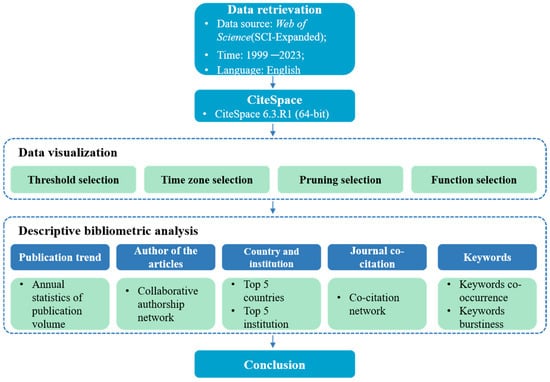
Figure 1.
Research stages and description.
3. Results and Discussion
3.1. Analysis of Publishing Trend
This study conducted a statistical analysis of the publication volume, as shown in Figure 2, which revealed an overall upward trend in the research domain of soil permeability at the watershed scale using the SWAT model over the past 25 years. This indicates the current prominence of this domain among researchers. The SWAT model was first used in 1999 to analyze excess rainfall on basin-scale basins [37]. Between 1999 and 2004, there was a temporary absence of new research findings in this field. From 2005 to 2017, research in this field showed a stable growth trend, with a total of 64 papers published, approximately 45% of the total literature. During this period, the literature mainly focused on the fields of Water Resources (45 articles), Agriculture (19 articles), Engineering (18 articles), and Environmental Sciences Ecology (16 articles). During the period from 2018 to 2021, a slight decline was observed. However, after 2021, there was a resurgence in publication volume. Additionally, since 2018, there has been increased attention in the fields of Environmental Sciences, Ecology, Geology, Meteorology Atmospheric Sciences, and Biodiversity Conservation. This suggests that scholars are increasingly concentrating on the relationship between this field and ecosystems.
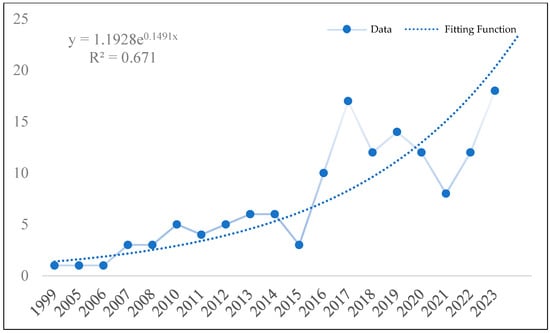
Figure 2.
The volume of literature analyzing soil infiltration at the watershed scale using the SWAT model from 1999 to 2023 (the closer “R2” is to 1 in the graph, the more plausible the data is).
3.2. Analysis of the Authors of the Articles
In CiteSpace, the g-index determines the number of nodes (articles, authors, countries, or journals) displayed in the network visualization. By adjusting the scaling factor k, the density of the network can be controlled [36]. In this study, after a series of experiments, we set k = 20, and the time slice was set as 1 (year), which enables the inclusion of nodes representing the most influential authors.
The most prolific author in this field is Steenhuis, Tammo S., with a total of five articles. The second authors are Easton, Zachary M., Fuka, Daniel R., Arnold, J.G., and Collick, Amy S., each with four articles. By setting the note type to “author”, we constructed a knowledge graph of the articles’ authors (Figure 3). There are 287 nodes, 444 lines, and a network density of 0.0108. Each node represents an author, with larger nodes indicating more frequent occurrences. Lines between nodes indicate that they have a cooperative relationship. Figure 3 shows that there are currently two major core research teams in this field: those centered on Steenhuis, Tammo S., and Easton, Zachary M., and those centered on Arnold, J.G. The teams are essentially in an independent research phase among themselves.
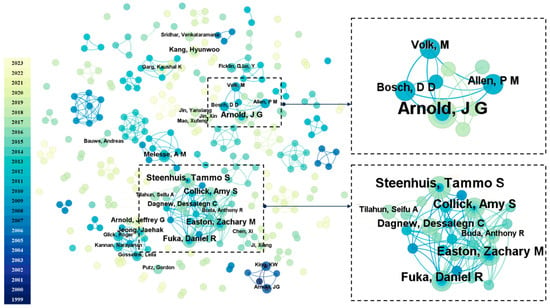
Figure 3.
Collaborative authorship mapping, 1999–2023 (authors with more than two publications are labeled).
3.3. Analysis of Country and Institution
In order to reveal centers of expertise and prominent research groups fostering international collaboration and knowledge exchange, we analyzed maps of collaborative networks and maps of institutional collaboration in 41 countries. In CiteSpace, the network node types were set as “Country” and “Institution”, the time slice was set as 1, and the g-index was set at k = 25.
Firstly, Table 1 enumerates countries and journals that have demonstrated outstanding academic contributions in this field, alongside the principal watersheds studied by researchers from each country. Among the top five countries, there are three developed and two developing nations. The United States has published the most studies (72 articles), followed by China, Ethiopia, Canada, and Germany. There are relatively more researchers in the United States and China; the SWAT model was developed by researchers in the United States, so there are relatively many publications from these two countries. In Ethiopia, river basins such as the Blue Nile Basin have garnered considerable global attention due to their pronounced susceptibility to climate change, consequently attracting extensive international collaboration and research efforts. Among Asian countries, China, India, Iran, South Korea, and Japan are the principal contributors to research in this field. Conversely, Thailand, Vietnam, and Indonesia have comparatively fewer studies, potentially due to challenges related to data acquisition and limitations in research interests. Based on Figure 4 (national collaboration mapping), it could be observed that countries with different levels of development exhibit varying attitudes towards collaboration in using the “SWAT” model for watershed soil infiltration analysis. Developed countries typically have a positive attitude towards scientific collaboration in this field, supported by a strong research foundation and substantial investment in collaborative research efforts. The United States played a mediator role in the national collaboration network, indicating deeper collaborative relationships with other regions in this field and a significant leading position. Germany followed closely behind.

Table 1.
Top 5 countries and institutions in the literature on soil infiltration in watersheds scale using the SWAT model, 1999–2023.
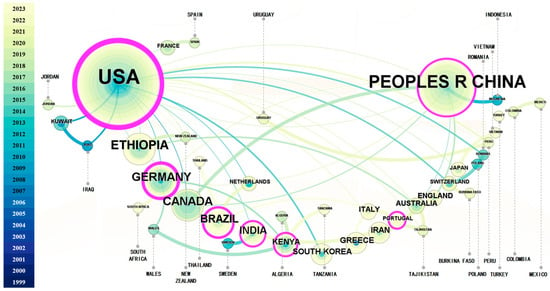
Figure 4.
National collaborative mapping, 1999–2023 (the node size represents the number of publications that originated from the country, and the purple rings represent the mediated centrality of the node, and their thickness reflects the centrality value).
Secondly, we identified that the top five institutions collectively published 61 articles (Table 1). Among them, four institutions are located in the United States. They are the United States Department of Agriculture (USDA) (14 articles), Cornell University (9 articles), Agricultural Research Service (6 articles), and Purdue University (6 articles). Additionally, two institutions are based in China: Chinese Academy of Sciences (13 articles) and Beijing Normal University (7 articles). This indicates that academic institutions in the United States hold a prominent position in researching soil infiltration at the watershed scale using the SWAT model, followed by China. Bahir Dar University (6 articles) in Ethiopia is also one of the main contributing institutions. These research institutions have formed relatively dense collaborative networks, while there are still a significant number of institutions operating independently in their research endeavors (Figure 5).
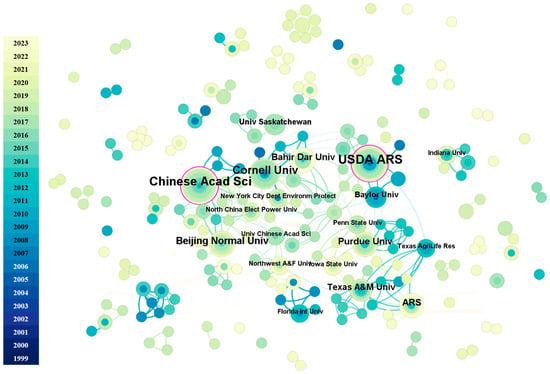
Figure 5.
Institutional collaborative mapping, 1999–2023 (the node size represents the number of publications that originated from the institution, and the purple rings represent the mediated centrality of the node, and their thickness reflects the centrality value).
3.4. Analysis of Journal Co-Citation
To provide an overview of the types of journals that have served the field of soil infiltration research at the watershed scale using the SWAT model during the period 1999–2023, we conducted a journal co-citation analysis (with g-index k = 5, time slice = 1) of the retrieved literature as demonstrated in Figure 6. The majority of the cited journals have relatively high impact factors, indicating a certain level of scholarly attention towards research related to watershed-scale soil infiltration analysis using the SWAT model. This provides a theoretical foundation for further scientific advancement in this field and its related research directions in the future. As shown in Figure 6, the journal with the highest number of citations is the Journal of Hydrology (133), followed by Hydrological Processes (115) and Journal of the American Water Resources Association (115). Moreover, research in this field spans various disciplines, including Earth science, environmental science, agricultural and forestry science, ecology, soil science, water resources, and hydrological management.
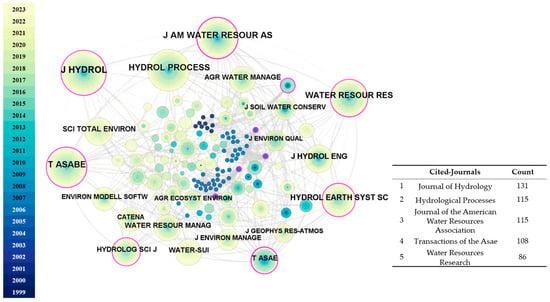
Figure 6.
Journal co-citation analysis mapping, 1999–2023 (the node size indicates the number of citations originating from the journal, and the purple rings represent the mediated centrality of the node, and their thickness reflects the centrality value).
3.5. Landmark Literature
Table 2 presents the top 10 highest-cited articles from the Web of Science Core Collection database (with Science Citation Index Expanded only), along with their main research contents. Mango et al. applied the SWAT model to analyze how hydrological processes in Kenya’s upper Mara River Basin are influenced by variations in climate and land use [38]. It has been cited 299 times, making it the most cited paper in the research database. The study recommended enhanced land management strategies aimed at increasing soil infiltration capacity and aquifer replenishment, thus improving resilience to extensive climate variability. The papers by Easton et al. and J. G. Arnold et al. follow closely, cited 219 and 146 times, respectively. They revised and updated the traditional SWAT model to better reflect the controls on infiltration, runoff, and groundwater flow [39,40].
In studies focusing on the SWAT framework, Jeong et al. designed a sub-hourly rainfall-runoff model within SWAT to facilitate assessments of hydrology and nonpoint source pollution [41]. Luo et al. introduced a slow-response reservoir baseflow method into the traditional SWAT model to simulate hydrological processes [42]. White et al. developed a new physically-based water balance SWAT-WB model, which could provide better simulation results for water balance in specific areas compared to the traditional SWAT-CN [43].
Additionally, King et al., Ayele et al., and Garg et al. applied the SWAT method to watershed-scale modeling in agriculture, investigating surface infiltration and runoff characteristics under agricultural land conditions [37,44,45]. Han et al. developed an analytical framework that integrated the SWAT model with the Ensemble Kalman Filter (EnKF) and a semi-distributed hydrological model at the watershed scale to investigate the impacts of assimilating surface soil hydrological data on hydrological processes [46].
From the top ten most cited articles, we found that the SWAT model plays a crucial role in analyzing watershed soil permeability. In the future, increased emphasis should be placed on advancing and applying the SWAT model, alongside its integration with complementary models, to more accurately represent processes like soil permeability and runoff generation. This will enhance the protection, development, utilization, and management of watersheds. Additionally, we conducted a statistical analysis of the journals where the 141 selected papers were published and found that over 30% of the papers came from the three journals: Journal of Hydrology (12%), Water (11%), and Hydrological Processes (10%). This reflected the leading position of these three journals in the field.

Table 2.
Top 10 articles based on global citation.
Table 2.
Top 10 articles based on global citation.
| Reference | Main Content | Type | Citations |
|---|---|---|---|
| Mango et al. (2011) [38] | The research advocated placing greater emphasis on advancing land management measures to boost soil infiltration and groundwater recharge, thereby strengthening adaptation to pervasive climate change. | Article | 299 |
| Easton et al. (2008) [39] | The paper redefined the curve number (CN) and available soil water content within the conventional SWAT framework, leading to the development of the SWAT-VSA model. This updated version enhances the accuracy of shallow groundwater depth predictions and the delineation of runoff source areas. These improvements are of considerable value for assessing and informing watershed management strategies. | Article | 219 |
| J. G. Arnold et al. (2010) [40] | This research refined the Soil and Water Assessment Tool (SWAT) to more precisely capture the intricate factors influencing infiltration, runoff production, and the interactions between surface water and groundwater flow. | Article | 146 |
| King et al. (1999) [37] | The paper integrated the GAML excess rainfall approach and a sub-daily routing method into the SWAT framework to address the requirements for modeling alternative excess rainfall scenarios in agriculture-oriented watershed studies. | Article | 137 |
| Jeong et al. (2010) [41] | The paper presented the creation and evaluation of a sub-hourly rainfall-runoff module within the SWAT model. Statistical analyses demonstrate that this sub-hourly adaptation shows strong potential for hydrological and nonpoint source pollution assessments, though additional refinement remains necessary to advance its water quality simulation capabilities. | Article | 126 |
| Ayele et al. (2017) [44] | The paper calibrated and validated the SWAT model to investigate watershed management prioritization in Ethiopia’s Upper Blue Nile River Basin. The findings revealed that cropland influences surface infiltration rates and runoff dynamics, while also modifying interactions between the shallow water table and saturated excess runoff, thereby shaping patterns of water and sediment transport. | Article | 108 |
| Luo et al. (2012) [42] | Building on the single-reservoir baseflow method within the SWAT model, the paper introduced an additional slow-response reservoir and applied this enhanced approach to the Manas River Basin in the Tianshan Mountains of Northwest China. | Article | 101 |
| Garg et al. (2012) [45] | The paper employed the ArcSWAT model (a hydrological tool for simulating agricultural water interventions) to assess the impacts of diverse soil and water management strategies versus non-intervention conditions in India’s Kothapally watershed. It indicated that intervention measures enhance soil infiltration and water retention capacity, resulting in positive impacts on hydrology. | Article | 94 |
| White et al. (2011) [43] | The paper emphasized that in Ethiopia’s Blue Nile headwaters, streamflow simulated with the newly developed physically based water balance SWAT (SWAT-WB) outperformed the traditional curve number-based SWAT (SWAT-CN), delivering a more accurate representation of the watershed’s water balance than the CN approach. | Article | 93 |
| Han et al. (2012) [46] | The paper combined the SWAT model with the Ensemble Kalman Filter (EnKF) and a semi-distributed hydrological model at the watershed scale to examine the influence of assimilating surface soil hydrological data on hydrological processes. The study indicated that remotely sensed surface soil moisture observations hold considerable promise for application in watershed-scale water resource management. | Article | 91 |
3.6. Research Contents
3.6.1. Keyword Co-Occurrence Analysis
Keywords convey the core themes of a study, with higher frequencies indicating the prevailing research hotspots and focal points at that time [47]. In the CiteSpace analysis, the network node type was set as “keyword”, with a time slice of 1 year, and the g-index was set to k = 20. Figure 7 illustrates the keyword co-occurrence network within this research domain spanning the years 1999 to 2023. The graph comprises 271 nodes and 999 lines, with a density of 0.0273. The size of each node is proportional to the frequency of the corresponding keyword. Table 3 lists the top 10 keywords based on frequency and intermediary centrality. The results indicate that the “SWAT model” is the most frequently occurring keyword (36 times), followed by “runoff” (33 times), “soil” (32 times), and “river basin” (30 times). The keyword with the highest intermediary centrality is “catchment” (0.29), followed by “calibration” (0.27), suggesting that the focal point of research in this field may lie in enhancing water and soil conservation capabilities. Furthermore, keywords such as “climate change” and “infiltration” exhibit high occurrence frequencies and certain mediated centrality, confirming that the two themes should be focal points of attention in this field, regardless of the indicator used.
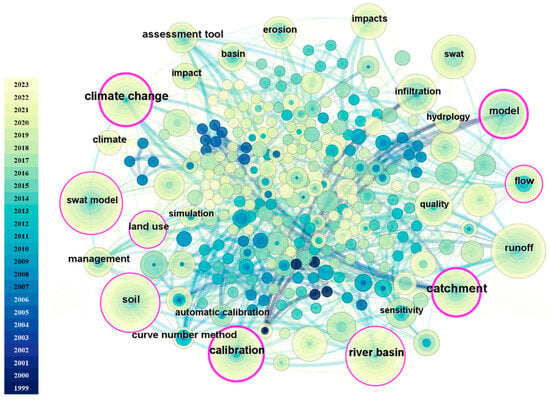
Figure 7.
Keyword co-occurrence network mapping, 1999–2023 (The node size indicates the frequency of occurrence of the keyword, and the purple rings represent the mediated centrality of the node, and their thickness reflects the centrality value).

Table 3.
Keyword frequency table (sorted by keyword count and centrality).
3.6.2. Keywords with the Strongest Citation Bursts
CiteSpace ranks prominently displayed keywords according to their burst strength, which reflects the prominence and significance of these research directions [48]. Setting γ = 0.54, we draw the keyword burst detection graph for this field (Figure 8). The picture presents the top 20 keywords alongside their strength, burst start time, and end time. The light blue line represents that the keyword has not yet appeared in the period, the dark blue line represents that the keyword appeared in the period, and the red line represents the period when the use of the keyword increased significantly (which indicates a significant increase in academic interest in the keyword during that period). To precisely analyze the current status and development trends of the research field of “soil infiltration at the watershed scale using the SWAT model”, the entire study period was divided into three distinct phases.
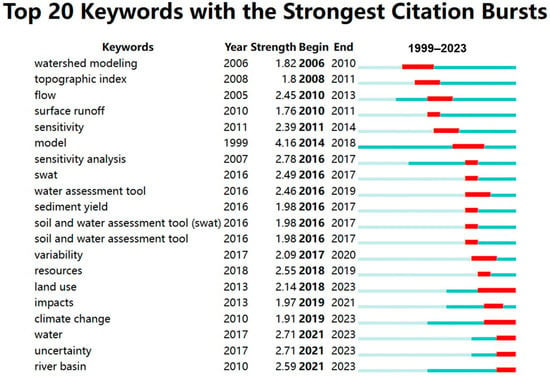
Figure 8.
Top 20 keywords with the strongest citation bursts. (“Year” represents the year in which the keyword began to appear; “Strength” represents the degree of emergence of the keyword, the higher the value, the higher the research heat; “Begin-End” represents a burst of research fervor for a keyword at a particular time; “light blue line” represents the keyword has not yet appeared in the period; “dark blue line” represents the keyword appeared in the period; “red line” the period when the use of the keyword increased significantly).
From 1999 to 2004, the research was in an initial stage, and there was a period of research stagnation between 2000 and 2004. The key term during this period was only “model”. Researchers focused on the demand for modeling excessive rainfall at the watershed scale based on agriculture [37]. This period laid the foundation for subsequent studies on watershed-scale modeling, providing a reference for future research articles.
From 2005 to 2017, the research was in a developmental stage, with a considerable number of studies and the emergence of numerous key terms, including “topographic index”, “flow”, and “sensitivity”, being observed at high frequencies. During this stage, researchers primarily focused on adjusting and updating the SWAT model to analyze hydrological components at the watershed scale, simulate precipitation-runoff processes, and enhance control over infiltration, runoff, and groundwater flow. In terms of study subjects, the focus was mainly on analyzing agricultural watersheds [49,50], watershed divides into hilly or valley areas [40], and grasslands or forest buffer zones around watersheds [11,51]. Notably, Ma et al. proposed that “In the short and medium term, changes in land cover have a greater impact on river water than climate change” [51].
From 2018 to 2023, the research was in a boom stage; “land use” and “climate change” garnered widespread attention, and emergent terms have not yet ended. This suggests that these terms may represent new topics and even the primary forefront of the field. The World Meteorological Organization (WMO) issued the WMO Statement on the State of the Global Climate in 2019, reported that 2019 experienced frequent and intense heatwaves, along with extreme weather events that disrupted rainfall patterns, significantly impacting health, food security, and water security, as well as human production, livelihoods, infrastructure, and biodiversity [52]. The “global climate indicators” encompass atmospheric components and energy changes resulting from the buildup of greenhouse gases and other influences, as well as the corresponding responses of land, ocean, and cryosphere systems [52]. The United Nations’ “World Water Development Report 2023” emphasized that securing water resources through sustainable water management can help lessen the effects of climate change and extreme weather events [53]. Meanwhile, “climate change”, along with “land use” and “land cover”, exerts a significant influence on the hydrological balance of watershed systems [54,55]. Land-use practices may possess the potential to mitigate and adapt to the impacts of climate change [56]. Additionally, shifts in land use can alter key hydrological components, while effective land use planning can help maintain the long-term sustainability of ecosystem services within watersheds [57]. Therefore, in future research, there should be an increased focus on the synergistic interactions between “land use”, “climate change”, and watershed systems to promote global hydrological cycles, mitigate extreme weather events, and preserve biodiversity.
Analyzed the keywords with the strongest citation bursts, we found three main trends emerging in the research field of “analyzing soil infiltration at the watershed scale using the SWAT model”: (1) The scale of research is continuously expanding. (2) The research subjects are diversified, ranging from initially focusing on agricultural watersheds to surrounding areas such as hillsides, grasslands, and forests. (3) The research content becomes more systematic, emphasizing regional coordination and ecological sustainability. Therefore, against the backdrop of climate change, it is imperative to further investigate the rational application of the SWAT model for watershed-scale soil infiltration and its connection to sustainable ecosystem development.
4. Conclusions
This bibliometric analysis analyzed the field of “soil infiltration at the watershed scale using the SWAT model”, based on publications from the WOS Core Collection (with Science Citation Index Expanded only) database. We utilized CiteSpace software to analyze this field’s research status, hotspots, and trends. This study revealed that the field of “soil infiltration at the watershed scale using the SWAT model” has garnered widespread attention from scholars worldwide. Over time, the number of publications in this field has exhibited an upward trajectory. The research in this domain was interdisciplinary, spanning various fields, such as Earth science, environmental science, agricultural science, and ecology. From the analysis of cited journals and the ranking of citation frequency among the top ten articles, it was evident that the Journal of Hydrology and Hydrological Processes were the two most influential journals in this field. Scholars and research institutions from the United States, China, and Ethiopia have made significant contributions to this field. Steenhuis, Tammo S., stood out as a prolific and influential scholar. The current problem is that global research cooperation in this field remains relatively low, emphasizing the urgent need to enhance collaboration among scholars from different countries and institutions to advance the field. “Land use” and “climate change” were currently the hotspots of interest in this field. There are three developmental trends: (1) The scale of research is continuously expanding. (2) The research subjects are diversified, ranging from initially focusing on agricultural watersheds to surrounding areas such as hillsides, grasslands, and forests. (3) The research content becomes more systematic, emphasizing regional coordination and ecological sustainability. Against the backdrop of climate change, further investigation into the relationship between the research field of “soil infiltration at the watershed scale using the SWAT model” and ecosystems is warranted. Overall, this study provides new researchers with a comprehensive framework for understanding the field of watershed-scale soil infiltration research employing the SWAT model over the past 25 years. It objectively presents the key research hotspots and development trends in this domain, offering valuable reference for future scholars interested in studying soil infiltration at the watershed scale using the SWAT model.
As with other bibliometric studies, this study has some limitations. Firstly, all referenced literature was from the WOS core collection database (with Science Citation Index Expanded only), which may have resulted in the omission of some relevant publications. Secondly, the scope of search terms was limited; consequently, the literature search may not have captured all pertinent studies on watershed-scale soil infiltration employing the SWAT analysis approach. Thirdly, this study examined publication trends, countries, institutions, journals, authors, keywords, and the top ten most-cited articles; there may exist some deficiencies regarding the literature analysis and knowledge graph construction. Nonetheless, the findings of this study still offer a clear depiction of the current state and emerging trends of watershed-scale soil infiltration research based on the SWAT model. At the same time, we hope that future research will address these limitations to deliver a more precise and comprehensive evaluation of the literature in this field. We also hope that future studies can analyze the relevant areas of soil infiltration from multiple perspectives to promote a good ecological environment.
Funding
This work was supported by JSPS KAKENHI Grant-in-Aid for Scientific Research (B) (grant number 23H01584), and also supported by the Japan Science and Technology Agency SPRING Project (grant number JPMJSP2136).
Data Availability Statement
Data will be made available on request.
Conflicts of Interest
The authors declare no conflict of interest.
References
- Ilstedt, U.; Malmer, A.; Verbeeten, E.; Murdiyarso, D. The effect of afforestation on water infiltration in the tropics: A systematic review and meta-analysis. For. Ecol. Manag. Plant. For. Water 2007, 251, 45–51. [Google Scholar] [CrossRef]
- Zhao, Y.; Wu, P.; Zhao, S.; Feng, H. Variation of soil infiltrability across a 79-year chronosequence of naturally restored grassland on the Loess Plateau, China. J. Hydrol. 2013, 504, 94–103. [Google Scholar] [CrossRef]
- Sun, D.; Yang, H.; Guan, D.; Yang, M.; Wu, J.; Yuan, F.; Jin, C.; Wang, A.; Zhang, Y. The effects of land use change on soil infiltration capacity in China: A meta-analysis. Sci. Total Environ. 2018, 626, 1394–1401. [Google Scholar] [CrossRef] [PubMed]
- Lammers, R.W.; Miller, L.; Bledsoe, B.P. Effects of Design and Climate on Bioretention Effectiveness for Watershed-Scale Hydrologic Benefits. J. Sustain. Water Built Environ. 2022, 8, 04022011. [Google Scholar] [CrossRef]
- Walsh, C.J.; Roy, A.H.; Feminella, J.W.; Cottingham, P.D.; Groffman, P.M.; Morgan, R.P. The urban stream syndrome: Current knowledge and the search for a cure. J. N. Am. Benthol. Soc. 2005, 24, 706–723. [Google Scholar] [CrossRef]
- Vieux, B.E. Infiltration. In Distributed Hydrologic Modeling Using GIS; Vieux, B.E., Ed.; Springer: Dordrecht, The Netherlands, 2016; pp. 83–99. [Google Scholar] [CrossRef]
- Vafakhah, M.; Karamizad, F.; Sadeghi, S.H.R.; Noor, H. Spatial variations of runoff generation at watershed scale. Int. J. Environ. Sci. Technol. 2019, 16, 3745–3760. [Google Scholar] [CrossRef]
- Riza, S.; Sekine, M.; Kanno, A.; Yamamoto, K.; Imai, T.; Higuchi, T. Modeling soil landscapes and soil textures using hyperscale terrain attributes. Geoderma 2021, 402, 115177. [Google Scholar] [CrossRef]
- Sarangi, A.; Madramootoo, C.A.; Enright, P. Comparison of Spatial Variability Techniques for Runoff Estimation from a Canadian Watershed. Biosyst. Eng. 2006, 95, 295–308. [Google Scholar] [CrossRef]
- Desta, H.; Lemma, B. SWAT based hydrological assessment and characterization of Lake Ziway sub-watersheds, Ethiopia. J. Hydrol. Reg. Stud. 2017, 13, 122–137. [Google Scholar] [CrossRef]
- Bosch, D.; Arnold, J.; Volk, M.; Allen, P. Simulation of a Low-Gradient Coastal Plain Watershed Using the SWAT Landscape Model. Trans. Am. Soc. Agric. Biol. Eng. 2010, 53, 1445–1456. [Google Scholar] [CrossRef]
- Langhans, C.; Govers, G.; Diels, J.; Stone, J.J.; Nearing, M.A. Modeling scale-dependent runoff generation in a small semi-arid watershed accounting for rainfall intensity and water depth. Adv. Water Resour. 2014, 69, 65–78. [Google Scholar] [CrossRef][Green Version]
- Farajalla, N.S.; Vieux, B.E. Capturing the essential spatial variability in distributed hydrological modelling: Infiltration parameters. Hydrol. Process. 1995, 9, 55–68. [Google Scholar] [CrossRef]
- Downer, C.W.; Ogden, F.L. Appropriate vertical discretization of Richards’ equation for two-dimensional watershed-scale modelling. Hydrol. Process. 2004, 18, 1–22. [Google Scholar] [CrossRef]
- Starks, P.J.; Ross, J.D.; Heathman, G.C. Modeling the Spatial and Temporal Distribution of Soil Moisture at Watershed Scales Using Remote Sensing and GIS. In Proceedings of the Spatial Methods for Solution of Environmental and Hydrologic Problems—Science, Policy, and Standardization, Reno, Nevada, 25 January 2001; ASTM International: West Conshohocken, PA, USA, 2001; pp. 58–74. [Google Scholar] [CrossRef]
- Das, S.; Deb, P.; Bora, P.K.; Katre, P. Comparison of RUSLE and MMF Soil Loss Models and Evaluation of Catchment Scale Best Management Practices for a Mountainous Watershed in India. Sustainability 2021, 13, 232. [Google Scholar] [CrossRef]
- Aloui, S.; Mazzoni, A.; Elomri, A.; Aouissi, J.; Boufekane, A.; Zghibi, A. A review of Soil and Water Assessment Tool (SWAT) studies of Mediterranean catchments: Applications, feasibility, and future directions. J. Environ. Manag. 2023, 326, 116799. [Google Scholar] [CrossRef]
- Tan, M.L.; Gassman, P.W.; Yang, X.; Haywood, J. A review of SWAT applications, performance and future needs for simulation of hydro-climatic extremes. Adv. Water Resour. 2020, 143, 103662. [Google Scholar] [CrossRef]
- Arnold, J.G.; Srinivasan, R.; Muttiah, R.S.; Williams, J.R. Large Area Hydrologic Modeling and Assessment Part I: Model Development1. J. Am. Water Resour. Assoc. 1998, 34, 73–89. [Google Scholar] [CrossRef]
- Hoang, L.; Schneiderman, E.M.; Moore, K.E.B.; Mukundan, R.; Owens, E.M.; Steenhuis, T.S. Predicting saturation-excess runoff distribution with a lumped hillslope model: SWAT-HS. Hydrol. Process. 2017, 31, 2226–2243. [Google Scholar] [CrossRef]
- Engel, B.A.; Srinivasan, R.; Arnold, J.; Rewerts, C.; Brown, S.J. Nonpoint-Source (NPS) Pollution Modeling Using Models Integrated with Geographic Information-Systems (GIS). Water Sci. Technol. 1993, 28, 685–690. [Google Scholar] [CrossRef]
- Bieger, K.; Arnold, J.G.; Rathjens, H.; White, M.J.; Bosch, D.D.; Allen, P.M.; Volk, M.; Srinivasan, R. Introduction to SWAT+, A Completely Restructured Version of the Soil and Water Assessment Tool. J. Am. Water Resour. Assoc. 2017, 53, 115–130. [Google Scholar] [CrossRef]
- Yen, H.; Park, S.; Arnold, J.G.; Srinivasan, R.; Chawanda, C.J.; Wang, R.; Feng, Q.; Wu, J.; Miao, C.; Bieger, K.; et al. IPEAT+: A Built-In Optimization and Automatic Calibration Tool of SWAT+. Water 2019, 11, 1681. [Google Scholar] [CrossRef]
- Rocha, E.O.; Calijuri, M.L.; Santiago, A.F.; de Assis, L.C.; Alves, L.G.S. The Contribution of Conservation Practices in Reducing Runoff, Soil Loss, and Transport of Nutrients at the Watershed Level. Water Resour. Manag. 2012, 26, 3831–3852. [Google Scholar] [CrossRef]
- Qi, J.; Lee, S.; Zhang, X.; Yang, Q.; McCarty, G.W.; Moglen, G.E. Effects of surface runoff and infiltration partition methods on hydrological modeling: A comparison of four schemes in two watersheds in the Northeastern US. J. Hydrol. 2020, 581, 124415. [Google Scholar] [CrossRef]
- Gassman, P.W.; Reyes, M.R.; Green, C.H.; Arnold, J.G. The Soil and Water Assessment Tool: Historical Development, Applications, and Future Research Directions. Trans. Am. Soc. Agric. Biol. Eng. 2007, 50, 1211–1250. [Google Scholar] [CrossRef]
- Gassman, P.W.; Sadeghi, A.M.; Srinivasan, R. Applications of the SWAT Model Special Section: Overview and Insights. J. Environ. Qual. 2014, 43, 1–8. [Google Scholar] [CrossRef] [PubMed]
- Francesconi, W.; Srinivasan, R.; Pérez-Miñana, E.; Willcock, S.P.; Quintero, M. Using the Soil and Water Assessment Tool (SWAT) to model ecosystem services: A systematic review. J. Hydrol. 2016, 535, 625–636. [Google Scholar] [CrossRef]
- Wen, C.; Zhen, Z.; Zhang, L.; Yan, C. A bibliometric analysis of river health based on publications in the last three decades. Environ. Sci. Pollut. Res. 2023, 30, 15400–15413. [Google Scholar] [CrossRef] [PubMed]
- Chen, C. Science Mapping: A Systematic Review of the Literature. J. Data Inf. Sci. 2017, 2, 1–40. [Google Scholar] [CrossRef]
- Chen, C.; Song, M. Visualizing a field of research: A methodology of systematic scientometric reviews. PLoS ONE 2019, 14, e0223994. [Google Scholar] [CrossRef]
- Chen, C.; Ibekwe-SanJuan, F.; Hou, J. The structure and dynamics of cocitation clusters: A multiple-perspective cocitation analysis. J. Am. Soc. Inf. Sci. Technol. 2010, 61, 1386–1409. [Google Scholar] [CrossRef]
- Jiang, Y.; Hou, L.; Shi, T.; Gui, Q. A Review of Urban Planning Research for Climate Change. Sustainability 2017, 9, 2224. [Google Scholar] [CrossRef]
- Zhao, J.; Zhang, N. Environmental regulation and labor market: A bibliometric analysis. Environ. Dev. Sustain. 2023, 25, 6095–6116. [Google Scholar] [CrossRef]
- Leal Filho, W.; Dedeoglu, C.; Dinis, M.A.P.; Salvia, A.L.; Barbir, J.; Voronova, V.; Abubakar, I.R.; Iital, A.; Pachel, K.; Huthoff, F.; et al. Riverine Plastic Pollution in Asia: Results from a Bibliometric Assessment. Land 2022, 11, 1117. [Google Scholar] [CrossRef]
- Wang, M.; Jiang, Z.; Ikram, R.M.A.; Sun, C.; Zhang, M.; Li, J. Global Paradigm Shifts in Urban Stormwater Management Optimization: A Bibliometric Analysis. Water 2023, 15, 4122. [Google Scholar] [CrossRef]
- King, K.; Arnold, J.; Bingner, R. Comparison of Green-Ampt and Curve Number Methods on Goodwin Creek Watershed Using SWAT. Trans. ASAE 1999, 42, 919–926. [Google Scholar] [CrossRef]
- Mango, L.M.; Melesse, A.M.; McClain, M.E.; Gann, D.; Setegn, S.G. Land use and climate change impacts on the hydrology of the upper Mara River Basin, Kenya: Results of a modeling study to support better resource management. Hydrol. Earth Syst. Sci. 2011, 15, 2245–2258. [Google Scholar] [CrossRef]
- Easton, Z.M.; Fuka, D.R.; Walter, M.T.; Cowan, D.M.; Schneiderman, E.M.; Steenhuis, T.S. Re-conceptualizing the soil and water assessment tool (SWAT) model to predict runoff from variable source areas. J. Hydrol. 2008, 348, 279–291. [Google Scholar] [CrossRef]
- Arnold, J.G.; Allen, P.M.; Volk, M.; Williams, J.R.; Bosch, D.D. Assessment of Different Representations of Spatial Variability on SWAT Model Performance. Trans. ASABE 2010, 53, 1433–1443. [Google Scholar] [CrossRef]
- Jeong, J.; Kannan, N.; Arnold, J.; Glick, R.; Gosselink, L.; Srinivasan, R. Development and Integration of Sub-hourly Rainfall–Runoff Modeling Capability Within a Watershed Model. Water Resour. Manag. 2010, 24, 4505–4527. [Google Scholar] [CrossRef]
- Luo, Y.; Arnold, J.; Allen, P.; Chen, X. Baseflow simulation using SWAT model in an inland river basin in Tianshan Mountains, Northwest China. Hydrol. Earth Syst. Sci. 2012, 16, 1259–1267. [Google Scholar] [CrossRef]
- White, E.D.; Easton, Z.M.; Fuka, D.R.; Collick, A.S.; Adgo, E.; McCartney, M.; Awulachew, S.B.; Selassie, Y.G.; Steenhuis, T.S. Development and application of a physically based landscape water balance in the SWAT model. Hydrol. Process. 2011, 25, 915–925. [Google Scholar] [CrossRef]
- Ayele, G.T.; Teshale, E.Z.; Yu, B.; Rutherfurd, I.D.; Jeong, J. Streamflow and Sediment Yield Prediction for Watershed Prioritization in the Upper Blue Nile River Basin, Ethiopia. Water 2017, 9, 782. [Google Scholar] [CrossRef]
- Garg, K.K.; Karlberg, L.; Barron, J.; Wani, S.P.; Rockstrom, J. Assessing impacts of agricultural water interventions in the Kothapally watershed, Southern India. Hydrol. Process. 2012, 26, 387–404. [Google Scholar] [CrossRef]
- Han, E.; Merwade, V.; Heathman, G.C. Implementation of surface soil moisture data assimilation with watershed scale distributed hydrological model. J. Hydrol. 2012, 416–417, 98–117. [Google Scholar] [CrossRef]
- Huang, X.; Wang, K.-R.; Zou, Y.; Cao, X.-C. Development of global soil erosion research at the watershed scale: A bibliometric analysis of the past decade. Environ. Sci. Pollut. Res. 2021, 28, 12232–12244. [Google Scholar] [CrossRef] [PubMed]
- Su, H.-N.; Lee, P.-C. Mapping knowledge structure by keyword co-occurrence: A first look at journal papers in Technology Foresight. Scientometrics 2010, 85, 65–79. [Google Scholar] [CrossRef]
- Wang, X.; Shang, S.; Yang, W.; Melesse, A.M. Simulation of an Agricultural Watershed Using an Improved Curve Number Method in SWAT. Trans. ASABE 2008, 51, 1323–1339. [Google Scholar] [CrossRef]
- Migliaccio, K.; Srivastava, P. Hydrologic Components of Watershed-Scale Models. Trans. ASABE 2007, 50, 1695–1703. [Google Scholar] [CrossRef]
- Ma, X.; Xu, J.; van Noordwijk, M. Sensitivity of streamflow from a Himalayan catchment to plausible changes in land cover and climate. Hydrol. Process. 2010, 24, 1379–1390. [Google Scholar] [CrossRef]
- World Meteorological Organization (WMO). WMO Statement on the State of the Global Climate in 2019 [WWW Document]. 2020. Available online: https://library.wmo.int/records/item/56228-wmo-statement-on-the-state-of-the-global-climate-in-2019 (accessed on 20 May 2024).
- World Water Assessment Programme (WWAP). The United Nations World Water Development Report 2023: Partnerships and Cooperation for Water. UNESCO. [WWW Document]. 2023. Available online: https://unesdoc.unesco.org/ark:/48223/pf0000384655 (accessed on 20 May 2024).
- Tsvetkova, O.; Randhir, T.O. Spatial and temporal uncertainty in climatic impacts on watershed systems. Sci. Total Environ. 2019, 687, 618–633. [Google Scholar] [CrossRef]
- Jin, X.; Jin, Y.; Mao, X. Land Use/Cover Change Effects on River Basin Hydrological Processes Based on a Modified Soil and Water Assessment Tool: A Case Study of the Heihe River Basin in Northwest China’s Arid Region. Sustainability 2019, 11, 1072. [Google Scholar] [CrossRef]
- Ross, E.R.; Randhir, T.O. Effects of climate and land use changes on water quantity and quality of coastal watersheds of Narragansett Bay. Sci. Total Environ. 2022, 807, 151082. [Google Scholar] [CrossRef]
- Khorn, N.; Ismail, M.H.; Nurhidayu, S.; Kamarudin, N.; Sulaiman, M.S. Land use/land cover changes and its impact on runoff using SWAT model in the upper Prek Thnot watershed in Cambodia. Environ. Earth Sci. 2022, 81, 466. [Google Scholar] [CrossRef]
Disclaimer/Publisher’s Note: The statements, opinions and data contained in all publications are solely those of the individual author(s) and contributor(s) and not of MDPI and/or the editor(s). MDPI and/or the editor(s) disclaim responsibility for any injury to people or property resulting from any ideas, methods, instructions or products referred to in the content. |
© 2025 by the authors. Licensee MDPI, Basel, Switzerland. This article is an open access article distributed under the terms and conditions of the Creative Commons Attribution (CC BY) license (https://creativecommons.org/licenses/by/4.0/).